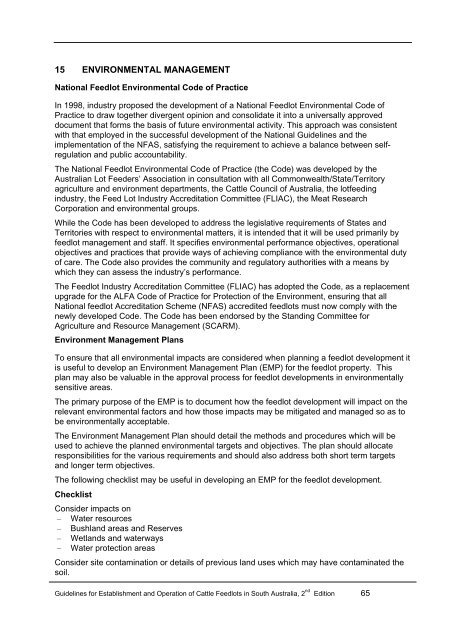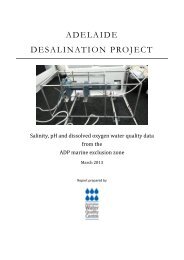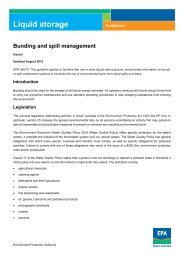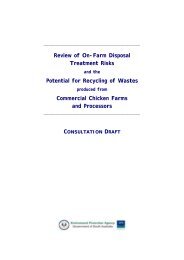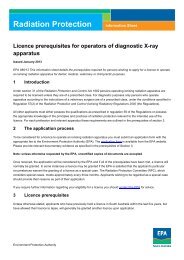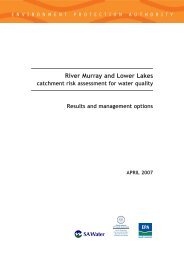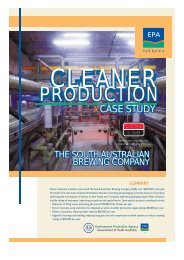Guidelines for Establishment and Operation of Cattle Feedlots in ...
Guidelines for Establishment and Operation of Cattle Feedlots in ...
Guidelines for Establishment and Operation of Cattle Feedlots in ...
You also want an ePaper? Increase the reach of your titles
YUMPU automatically turns print PDFs into web optimized ePapers that Google loves.
15 ENVIRONMENTAL MANAGEMENT<br />
National Feedlot Environmental Code <strong>of</strong> Practice<br />
In 1998, <strong>in</strong>dustry proposed the development <strong>of</strong> a National Feedlot Environmental Code <strong>of</strong><br />
Practice to draw together divergent op<strong>in</strong>ion <strong>and</strong> consolidate it <strong>in</strong>to a universally approved<br />
document that <strong>for</strong>ms the basis <strong>of</strong> future environmental activity. This approach was consistent<br />
with that employed <strong>in</strong> the successful development <strong>of</strong> the National <strong>Guidel<strong>in</strong>es</strong> <strong>and</strong> the<br />
implementation <strong>of</strong> the NFAS, satisfy<strong>in</strong>g the requirement to achieve a balance between selfregulation<br />
<strong>and</strong> public accountability.<br />
The National Feedlot Environmental Code <strong>of</strong> Practice (the Code) was developed by the<br />
Australian Lot Feeders’ Association <strong>in</strong> consultation with all Commonwealth/State/Territory<br />
agriculture <strong>and</strong> environment departments, the <strong>Cattle</strong> Council <strong>of</strong> Australia, the lotfeed<strong>in</strong>g<br />
<strong>in</strong>dustry, the Feed Lot Industry Accreditation Committee (FLIAC), the Meat Research<br />
Corporation <strong>and</strong> environmental groups.<br />
While the Code has been developed to address the legislative requirements <strong>of</strong> States <strong>and</strong><br />
Territories with respect to environmental matters, it is <strong>in</strong>tended that it will be used primarily by<br />
feedlot management <strong>and</strong> staff. It specifies environmental per<strong>for</strong>mance objectives, operational<br />
objectives <strong>and</strong> practices that provide ways <strong>of</strong> achiev<strong>in</strong>g compliance with the environmental duty<br />
<strong>of</strong> care. The Code also provides the community <strong>and</strong> regulatory authorities with a means by<br />
which they can assess the <strong>in</strong>dustry’s per<strong>for</strong>mance.<br />
The Feedlot Industry Accreditation Committee (FLIAC) has adopted the Code, as a replacement<br />
upgrade <strong>for</strong> the ALFA Code <strong>of</strong> Practice <strong>for</strong> Protection <strong>of</strong> the Environment, ensur<strong>in</strong>g that all<br />
National feedlot Accreditation Scheme (NFAS) accredited feedlots must now comply with the<br />
newly developed Code. The Code has been endorsed by the St<strong>and</strong><strong>in</strong>g Committee <strong>for</strong><br />
Agriculture <strong>and</strong> Resource Management (SCARM).<br />
Environment Management Plans<br />
To ensure that all environmental impacts are considered when plann<strong>in</strong>g a feedlot development it<br />
is useful to develop an Environment Management Plan (EMP) <strong>for</strong> the feedlot property. This<br />
plan may also be valuable <strong>in</strong> the approval process <strong>for</strong> feedlot developments <strong>in</strong> environmentally<br />
sensitive areas.<br />
The primary purpose <strong>of</strong> the EMP is to document how the feedlot development will impact on the<br />
relevant environmental factors <strong>and</strong> how those impacts may be mitigated <strong>and</strong> managed so as to<br />
be environmentally acceptable.<br />
The Environment Management Plan should detail the methods <strong>and</strong> procedures which will be<br />
used to achieve the planned environmental targets <strong>and</strong> objectives. The plan should allocate<br />
responsibilities <strong>for</strong> the various requirements <strong>and</strong> should also address both short term targets<br />
<strong>and</strong> longer term objectives.<br />
The follow<strong>in</strong>g checklist may be useful <strong>in</strong> develop<strong>in</strong>g an EMP <strong>for</strong> the feedlot development.<br />
Checklist<br />
Consider impacts on<br />
– Water resources<br />
– Bushl<strong>and</strong> areas <strong>and</strong> Reserves<br />
– Wetl<strong>and</strong>s <strong>and</strong> waterways<br />
– Water protection areas<br />
Consider site contam<strong>in</strong>ation or details <strong>of</strong> previous l<strong>and</strong> uses which may have contam<strong>in</strong>ated the<br />
soil.<br />
<strong>Guidel<strong>in</strong>es</strong> <strong>for</strong> <strong>Establishment</strong> <strong>and</strong> <strong>Operation</strong> <strong>of</strong> <strong>Cattle</strong> <strong>Feedlots</strong> <strong>in</strong> South Australia, 2 nd Edition 65


